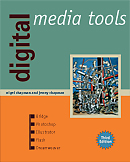
See the book at amazon.co.uk or amazon.com
Related Books

See Digital Multimedia at amazon.co.uk or amazon.com

See Web Design: A Complete Introduction at amazon.co.uk or amazon.com
The authors are not responsible for the content of any external sites linked to from digitalmediatools.org
All material on this site is ©2007–2010 MacAvon Media and may not be reproduced without permission.
Dreamweaver Teaching Notes
It would be a serious error to try to teach Dreamweaver without teaching something about HTML and CSS, and possibly JavaScript. The idea that you can do Web design visually is mistaken. You might be able to put together something that looked reasonable, but there is much more to good Web design than that. In order to use Dreamweaver effectively you need to understand what is going on beneath the appearance. Ideally, we would recommend that you teach the program in conjunction with a course based on Web Design: A Complete Introduction, but if you are not able to do that, at least include some theoretical lectures to support the practice.
The phenomenon of students wanting to run before they can walk, which we mentioned in the overview to these notes, seems to be particularly prevalent in the context of Web design. This is understandable. Students may see a need for having a Web site, but they won't see much point in using Dreamweaver as an inferior word processor, or mastering the CSS panel by formatting placeholder text. They therefore tend to turn to Dreamweaver only when they have a task to do, which almost always turns out to be large and complex to implement using Web technologies. This is a recipe for disaster. There is a logical order in which Web concepts must be learned, and a corresponding order in which Dreamweaver's features must be presented. This means that it is more suited to a formal presentation with a series of lectures than to informal teaching in a studio or lab situation. If this is not appropriate, then practical exercises of increasing difficulty should be done before any ambitious sites are attempted.
If students have already taken a course that covers HTML and CSS, they should have little trouble picking up Dreamweaver. However, if they are in an art and design department and have not been exposed to such a course, there will be serious difficulties in teaching this program. Visually oriented students may find it particularly difficult to deal with abstractions that create appearance, which is what is needed in order to understand Web technologies. Students with a strong computing background will be used to this, but will probably lack any knowledge of graphic design principles, and are likely to have a poorly developed visual sense. A short course on design ideas and layout, in particular, would be helpful to these students. Greg Berryman, Notes on Graphic Design and Visual Communication, revised edition (Crisp Publications:1990) and David Dabner, Graphic Design School (Thames and Hudson: 2004) may be useful sources. For most students, unless they are already learning about Web design, mere teaching of the program will not be adequate.
As we remark in the book, Dreamweaver is an odd man out in the CS3 suites. It does not (yet) have the standard Adobe interface, and it requires knowledge of the underlying technology in a way that the other programs do not. GoLive is an alternative, which is aimed more at designers (and does feature the standard CS3 interface) but it is not one that we can actively recommend. In fact, the poor quality of the code that GoLive generates demonstrates the problems of trying to hide Web technology.